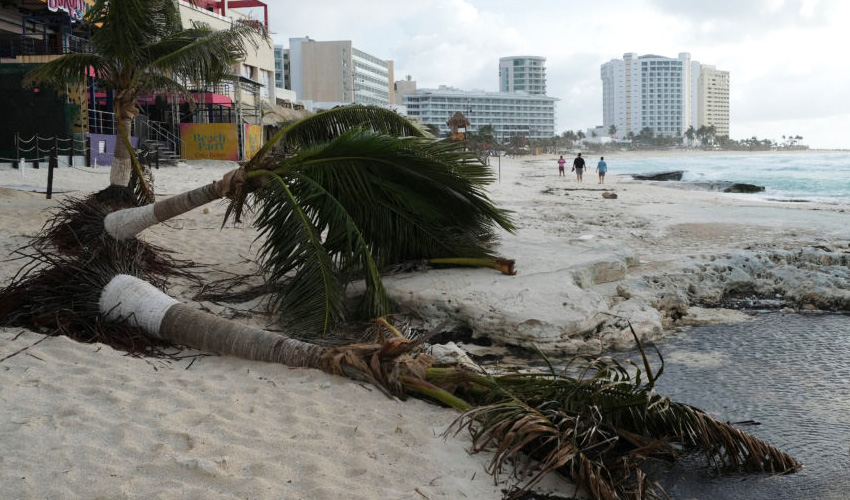Hurricane Milton made a significant impact on Florida after making landfall on the west coast on Wednesday night, leaving devastation in its wake. The storm, which originated as a tropical depression on October 5, rapidly intensified, becoming a formidable Category 5 hurricane before hitting Siesta Key.
The aftermath has resulted in widespread power outages, destruction of homes, and multiple tornadoes across the state, with officials warning residents of potential flooding and further hazards.
When and Where Did Hurricane Milton Make Landfall?
According to the National Hurricane Center (NHC), Hurricane Milton struck near Siesta Key, a barrier island town in Sarasota County, at approximately 20:30 EDT (03:00 GMT) on Wednesday. The hurricane's journey began with its formation as a tropical depression and quick escalation to Category 1 status on October 6.
By Monday, it reached its peak intensity as a Category 5 hurricane, boasting maximum sustained winds of 195 km/h (120 mph). As it approached Florida, Milton was downgraded to a Category 3 hurricane, hitting Siesta Key slightly earlier than anticipated.
How Did Milton impact Florida?
As Hurricane Milton swept through Florida, it brought a series of destructive elements, including power outages, tornadoes, and heavy rainfall. The following impacts have been reported:
Power outages
The storm caused significant disruptions to electricity supply, leaving over 3.2 million Floridians without power as of 06:46 EDT (10:46 GMT) on Thursday, according to PowerOutage.us. The western regions of the state experienced the brunt of the outages, and local utility companies, such as Florida Power and Light (FPL), have made efforts to restore power. Residents can check the status of their electricity through FPL's Power Tracker.
Tornadoes
In a grim report, Florida Governor Ron DeSantis confirmed that at least 19 tornadoes had been spawned by Hurricane Milton, affecting various counties. One tornado crossed the Everglades and Interstate 75, while another impacted Fort Myers, downing trees and damaging infrastructure, including a gas station canopy.
Heavy rainfall
The deluge began early Wednesday morning, with Gulf Coast city St. Petersburg recording an astounding 422 mm of rain. The heavy rainfall has raised concerns about flash flooding across southern Florida, prompting officials to monitor the situation closely.
Destruction of homes
As Milton approached land, approximately 125 homes—many of which were mobile homes and residences within senior citizen communities—were destroyed. Kevin Guthrie, director of the Florida Division of Emergency Management, confirmed the destruction, highlighting the vulnerability of certain communities in the hurricane’s path.
Loss of Life
While the precise number of fatalities related to the hurricane is still being assessed, reports from NBC News indicate at least two deaths in a retirement community in Fort Pierce on Florida's eastern coast, underlining the storm's tragic impact.
Storm surge
Warnings were issued along Florida's Gulf and Atlantic coastlines regarding the risk of storm surges as Milton approached. A storm surge refers to an abnormal rise in water levels caused by the force of the hurricane’s winds pushing water toward the shore. Such surges can result in extensive damage to coastal properties and infrastructure.
What emergency resources in place?
In response to the disaster, Florida authorities ordered evacuations for approximately 7.2 million residents across 15 counties. Governor DeSantis announced the deployment of about 9,000 National Guard personnel and 50,000 electricity grid workers to aid in recovery efforts. Search-and-rescue teams are ready to mobilize once the storm has passed.
The US National Weather Service (NWS) continues to disseminate warnings and safety advice. On Thursday, the NWS emphasized the dangers of driving through floodwaters, noting that over 50% of flood-related fatalities involve vehicles. Additionally, a flash flood emergency was declared for the Tampa Bay area, including the cities of Tampa, St. Petersburg, and Clearwater.
As of 06:46 EDT (10:46 GMT) on Thursday, Hurricane Milton has weakened to a Category 1 hurricane, with maximum sustained winds of 140 km/h (87 mph). The storm is currently located in the Atlantic Ocean, northeast of Cape Canaveral, Florida.
What happens next?
The NHC warns that heavy rainfall will persist, raising concerns of major flooding throughout Thursday. Forecasts predict an additional 200-350 mm of rain across central to northern portions of the Florida peninsula. Moreover, damaging gusts of wind may continue for several more hours in east-central and northeastern Florida, prompting officials to advise residents to remain indoors and steer clear of windows.
As recovery efforts begin, Florida braces for the aftermath of Hurricane Milton, with communities coming together to support one another in the face of adversity. The road ahead will undoubtedly be challenging, but the resilience of the Floridians shines through even in the most trying times.



























